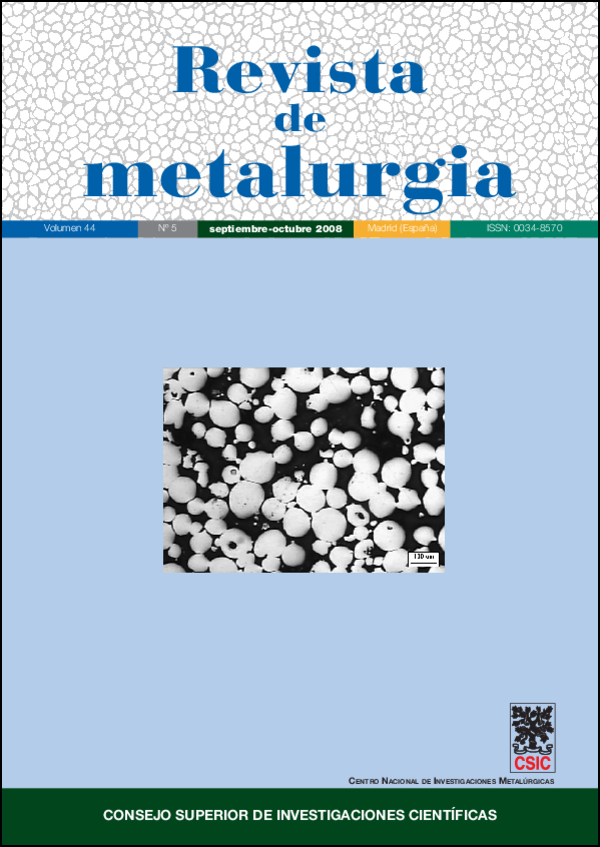Electrochemical extraction of microalloy carbides in Nb-steel
DOI:
https://doi.org/10.3989/revmetalm.0771Keywords:
(Nb, Ti)C precipitates, Electrochemical extraction, Steel matrix dissolution, Microalloyed steel, Anodic dissolution, FiltrationAbstract
An electrochemical extraction technique was evaluated as a characterization method of precipitates in microalloyed steels. To carry out this study, a fully precipitated Nb-modified SAE 8620, was used. The investigation was accomplished by varying the electrolyte composition and the filter pore sizes used to collect the particles. The quantification of Nb was performed by inductively coupled plasma-atomic emission spectroscopy (ICP-AES). Microscopy examination was also performed on extraction replicas and on residues collected in the acetate filters. Additionally, X-ray diffraction analysis (XRD) on the collected residues containing the precipitates was accomplished. The results showed that the dissolution rate is faster in the electrolyte consisting of 10 vol% HCl in water. Additionally, transmission electron microscopy (TEM) analysis along with chemical analysis by ICP-AES, showed that (Nb,Ti)C particles were collected in acetate filters with a pore size much larger than the precipitate size.
Downloads
References
[1] A. Kelly and R. B. Nicholson, Prog. Mater. Sci. 10 (1963) 149-391.
[2] H.K.D.H. Bhadeshia, Mater. Sci. Forum 35-42 (2003) 426-432.
[3] K.H.D.H. Badheshia, Mater. Sci. Technol. (1999) 22-29. doi:10.1179/026708399773002773
[4] T. Gladman, The Physical Metallurgy of Microalloyed Steels, 2a Ed., Eds. Institute of Materials, London, England, 1997.
[5] R. Wang, C.I. Garcia, M. Hua, K. Cho, H. Zhang and A.J. Deardo, ISIJ Int. 46 (2006) 1345-1353. doi:10.2355/isijinternational.46.1345
[6] J.H. Beynon and C.M. Sellars, ISIJ Int. 32 (1992) 359-367. doi:10.2355/isijinternational.32.359
[7] Y.H. Choi, H.C. Shin, C.S. Choi and Y.K. Lee, J. Phys. IV 120 (2004) 563-570.
[8] G. Krauss, Steels Processing, Structure and Performance. ASM International, 2005, pp. 230-232.
[9] K.A. Alogab, D.K. Matlock, J.G. Speer and H.J. Kleebe, ISIJ Int. 47 (2007) 307-316. doi:10.2355/isijinternational.47.307
[10] R. Lagneborg, T. Siwecki, S. Zajac and B. Hutchinson, Scand. J. Metall. 28 (1999)186-241.
[11] B.K. Panignhi, Bull. Mater. Sci. 24 (2001) 361-371. doi:10.1007/BF02708632
[12] R.D. Doherty, D.A Hughes, F.J. Humphreys, J.J. Jonas, D. Juul Jensen, M.E. Kassner, W.E. King, T.R. Mc Nelley, H.K. Mc Quieen and D. Rollelt, Mater. Sci. Eng. A 238 (1997) 219- 274. doi:10.1016/S0921-5093(97)00424-3
[13] M. Gómez, S.F. Medina, A. Quispe and P. Valles, ISIJ Int. 42 (2002) 423-431. doi:10.2355/isijinternational.42.423
[14] A.L. Rivas, D.M. Michal, M.E. Burnett and C.F. Musolff, Collection Papers 2nd Int. Symp. Microalloyed Bar and Forging Steels, C.J. Van Tyne, G. Krauss and D.K. Matlock, (Eds.) The Minerals, Metals & Materials Society, Golden, Colorado, U.S.A., 1996, pp. 159-172.
[15] H.J. Kestenbach and E.V. Morales, Acta Microsc. 7 (1998) 22–33.
[16] R.F. Morais, A. Reguly and L.H. de Almeida, J. Mater. Eng. Perform. 15 (2006) 494-498. doi:10.1361/105994906X124596
[17] J. Strid and K. E. Easterling, Acta Metall. 33 (1985) 2057-2074. doi:10.1016/0001-6160(85)90129-4
[18] European Report, EUR 20938 EN, 2002.
[19] M. Saeki, F. Kurosawa and M. Matsuo, Transactions ISIJ 26 (1986) 1017-1035.
[20] Y. Choi, B. S. Seong, S. C. Baik and H. Ch. Lee, ISIJ Int. 42 (2002) 889-893. doi:10.2355/isijinternational.42.889
[21] M. Tamura, H. Iida, H. Esaka and K. Shinozuka, ISIJ Int. 43 (2003) 1807-1813. doi:10.2355/isijinternational.43.1807
[22] S. Fuyu and C. Wenxua, Proc HSLA Steels, Processing, Properties and Applications, The Minerals, Metals &Materials Society, 1992, 43-50.
[23] H. J. Jun, K. B. Kang and C. G. Park, Scripta Mater. 49 (2003) 1081-1086. doi:10.1016/j.scriptamat.2003.08.013
[24] J.C. Herman, B. Donnay and V. Leroy, ISIJ 32 (1992) 779-785. doi:10.2355/isijinternational.32.779
[25] H. Walz and R. A. Bloom, J. Met.(1960) 928-932.
[26] W.R. Bandi, J.L. Lutz and L.M. Melnick, J. Iron Steel Inst. (1969) 348-352.
[27] L. Li and R. W. Messler, Metall. Mater. Trans. A 33 (2002) 2031-2042. doi:10.1007/s11661-002-0035-3
[28] K. W. Andrews and H. Hughes, Iron & Steel (1958) 43-50.
[29] H. Watanabe. Ph.D. Thesis, University of Michigan, 1975.
[30] R.W. Gurry, J. Christakos and C.D. Stricker, Trans. ASM 50 (1958) 105-127.
[31] I. Gustavsson, Corrosion and Metals Research Institute, 2006. Private communication.
[32] F. Yokota, A. Shimizu, T. Ishizuka and H. Morikawa. Determination of impurities in niobium carbide by high-pressure acid decomposition/ICP-AES. Bunseki Kagaku, Abstracts, 2000, pp. 49.
[33] K. Alogab, PhD. Thesis. ASPPRC. Colorado School of Mines, Golden, CO, U.S.A., 2004.
[34] A.L. Rivas, D. K. Matlock and J. G. Speer, Mater. Charact.
[35] R. Uemori, R. Chijiiwa, H. Tamehiro and H. Morikawa Appl. Surf. Sci., 76-77 (1994) 225-260.
[36] R. Kroger C and V. Diaz, J. Aerosol Sci. 27 (1996) 751-757. doi:10.1016/0021-8502(96)00006-7
[37] S. Matsuda and N. Okumura: Trans. Iron Steel Inst. Jpn. 18 (1878) 198.
Downloads
Published
How to Cite
Issue
Section
License
Copyright (c) 2008 Consejo Superior de Investigaciones Científicas (CSIC)

This work is licensed under a Creative Commons Attribution 4.0 International License.
© CSIC. Manuscripts published in both the printed and online versions of this Journal are the property of Consejo Superior de Investigaciones Científicas, and quoting this source is a requirement for any partial or full reproduction.
All contents of this electronic edition, except where otherwise noted, are distributed under a “Creative Commons Attribution 4.0 International” (CC BY 4.0) License. You may read the basic information and the legal text of the license. The indication of the CC BY 4.0 License must be expressly stated in this way when necessary.
Self-archiving in repositories, personal webpages or similar, of any version other than the published by the Editor, is not allowed.
















